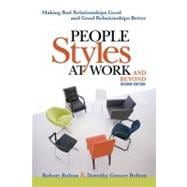
Note: Supplemental materials are not guaranteed with Rental or Used book purchases.
Purchase Benefits
What is included with this book?
ROBERT BOLTON and DOROTHY GROVER BOLTON (Cazenovia, N.Y) are co-founders of Ridge
Associates, which specializes in people skills training, leadership development,
interpersonal communication, and performance management. Their training and
coaching clients include many Fortune 500 companies and executives. They are the
authors of Social Style, Management Style.
| Introduction | p. 1 |
| Understanding Yourself and Others | |
| No Wonder We Have People Problems | p. 7 |
| People Are More Predictable than You Might Think | p. 16 |
| What's Your Style? | p. 24 |
| Two Keys to Understanding People | p. 28 |
| See Yourself as Others See You | p. 38 |
| The Driving Style and the Expressive Style | p. 43 |
| The Amiable Style and the Analytical Style | p. 54 |
| Make the Most of Your Gifts | p. 63 |
| Backup Styles: Extreme, Inappropriate, and Inflexible Behavior | p. 72 |
| Coping with Backup Behavior | p. 82 |
| Style Flex: A Key to Improved Relationships | |
| The Style Flex Solution to People Differences | p. 91 |
| Four Steps to Better Relationships | p. 99 |
| How to Identify Someone's Style | p. 107 |
| Flexing in Special Situations | p. 117 |
| Three Keys to Good Relationships | p. 127 |
| People Styles and Family Relationships | |
| The Art of Loving Someone Very Different from Yourself | p. 137 |
| Style-Based Parenting | p. 147 |
| Appendices | |
| For Amiables Only: How to Flex to Each Style | p. 155 |
| For Drivers Only: How to Flex to Each Style | p. 169 |
| For Expressives Only: How to Flex to Each Style | p. 187 |
| For Analyticals Only: How to Flex to Each Style | p. 202 |
| Bibliography | p. 219 |
| Index | p. 225 |
| Table of Contents provided by Ingram. All Rights Reserved. |
The New copy of this book will include any supplemental materials advertised. Please check the title of the book to determine if it should include any access cards, study guides, lab manuals, CDs, etc.
The Used, Rental and eBook copies of this book are not guaranteed to include any supplemental materials. Typically, only the book itself is included. This is true even if the title states it includes any access cards, study guides, lab manuals, CDs, etc.